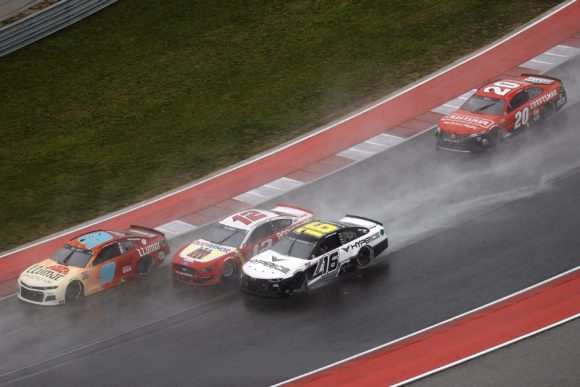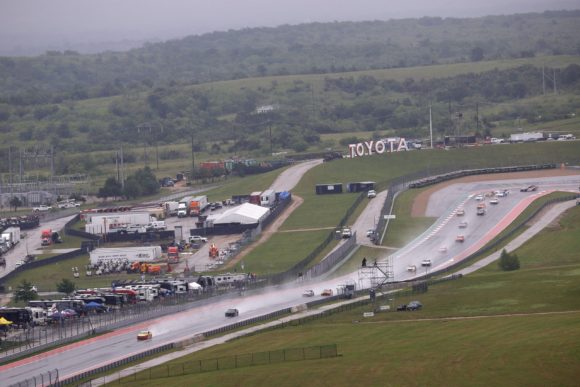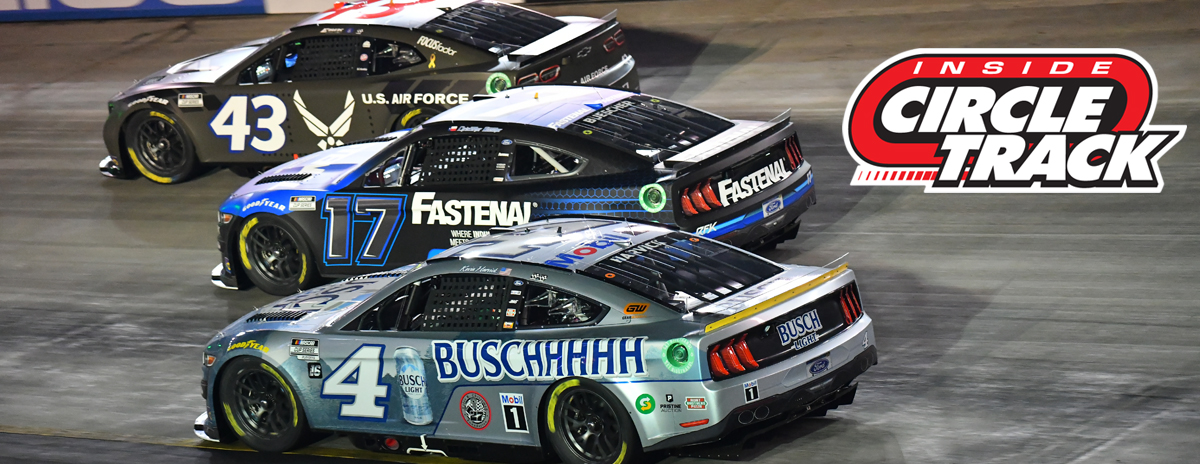
Cars threw up heavy spray from the standing water on the track(Photo: Getty Images)
I have never understood why, since the time NASCAR first threw out the possibility that its top-three series would employ windshield wipers and rain tires on road courses, so many have openly rooted for a NASCAR Cup Series event to be contested in wet conditions. Seemingly some members of the media have been the leaders in the desire to see the top stars in the sport slip and slide in bad weather. The attraction has supposedly been because doing so would be different and more interesting.
NASCAR itself has helped to promote the hype by even going so far as testing rain tires for the possibility of running an oval short track race on a saturated racing surface. And to some degree, there had been somewhat successful forays in the lower series on damp pavement such as last year’s NASCAR Xfinity Series race on the Charlotte Roval.
Enter the Echo Park Texas Grand Prix at the Circuit of the Americas weekend in Austin, TX. The weather forecasters proved to be correct and the rains came for Saturday’s NASCAR Camping World Truck Series race and Sunday’s NASCAR Cup Series on the track originally designed for Formula 1 competition.
Those who hoped for a Cup Series race in the rain finally got what they wanted in what, at times, proved to be a downpour which resulted in areas of standing water, especially on the 3.4-mile road course’s backstretch.
I have never been in favor of NASCAR cars racing in the rain. I understand the arguments, particularly that of the ticket holders who might not be able to come back on the next clear day. Still, it is my opinion that these heavy cars were never meant to race in wet conditions and shouldn’t be made to do so.

The track’s backstretch proved to be the most treacherous(Photo: Getty Images)
I know Formula 1 races in the wet and various other forms of racing do so as well but those are much lighter sports cars with drivers who have more experience in rainy conditions than most NASCAR racers. More, these cars are big, awkward giants in comparison to the rest of the racing world with no lights(other than the single flashing light in the rear window that was barely visible) and brakes that aren’t good enough for that type of racing.
Apart from the precipitation, there was more of an issue. As events unfortunately showed at COTA, visibility in the heavy spray was the real issue. It wasn’t just that the weather impacted the competition but it was dangerous.
Two separate crashes that involved cars driving completely under another car clearly demonstrated the danger. And those crashes were caused by the fact that drivers could not see well enough to be racing at that speed in those conditions and the fact that the cars cannot maneuver or slow quickly enough to avoid disaster.
Drivers such as Kevin Harvick, Kyle Busch, Michael McDowell, Denny Hamlin, and Martin Truex, Jr. were not shy about voicing their concerns either on their team radios or during television interviews.
Kevin Harvick talking with his crew over the radio following the crash he was involved in:
4 spotter- "What do we need to do, Rodney?"
Childers- "Load it up. we're done."
Harvick- "They need to load everybody up. That's the most unsafe thing I've ever seen." #NASCAR
— InsideCircleTrack.com (@ICTwebsite) May 23, 2021
Michael McDowell talking with his crew over the team radio as cars were coming to a restart:
McDowell- "We're just going to keep wrecking on this backstretch." #NASCAR
— InsideCircleTrack.com (@ICTwebsite) May 23, 2021
Kyle Busch talking to his crew over the team radio late in the race just before it was called:
Kyle Busch- "I can't see. These tires … no grip." #NASCAR
— InsideCircleTrack.com (@ICTwebsite) May 23, 2021
It’s easy to be a ‘Monday Morning Quarterback’ when something goes wrong. But I, for one, hoped we would never see the day in which there would be a NASCAR race in an all out rain storm. I have written of that hope multiple times. I don’t think I’m alone in saying that I hope we never do again. A slightly damp track with no or little rain falling is one thing but what they had in Texas on Sunday was something entirely untenable for these cars.
Let’s not do that again.
Richard Allen is a member of the National Motorsports Press Association
Respond to this piece on Twitter –> @RichardAllenIDR
or on Facebook –> InsideCircleTrack/Facebook
